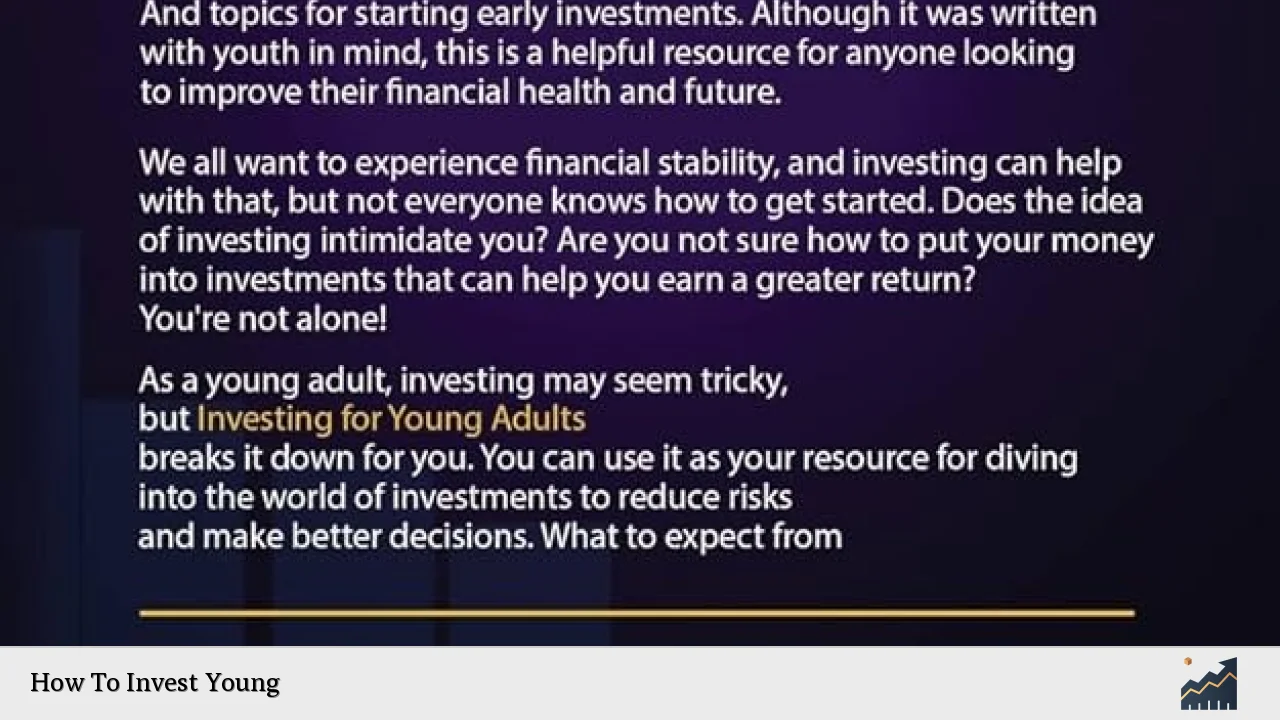Investing at a young age is one of the most powerful financial decisions you can make. With the advantage of time on your side, young investors can leverage compound interest and market growth to build significant wealth over their lifetimes. The earlier you start investing, the more your money can grow, making it essential to understand the various investment options and strategies available. This guide will explore practical steps for young individuals looking to start their investing journey.
| Investment Type | Description |
|---|---|
| Stocks | Ownership in a company, potential for high returns but comes with higher risk. |
| Bonds | Loans to companies or governments, generally lower risk than stocks. |
| Mutual Funds | Pools of money from many investors to buy a diversified portfolio of stocks and bonds. |
| ETFs | Exchange-traded funds that track indexes, offering diversification like mutual funds but traded like stocks. |
Understanding Your Financial Goals
Before diving into investments, it’s crucial to establish clear financial goals. These goals can be categorized into short-term and long-term objectives. Short-term goals may include saving for a vacation or a new car, while long-term goals typically focus on retirement savings or purchasing a home.
- Identify your objectives: Consider what you want to achieve financially in the next few years and decades.
- Assess your risk tolerance: Understand how much risk you are willing to take. Young investors often have a higher risk tolerance due to their long investment horizon.
- Create a timeline: Determine when you want to achieve these goals, as this will influence your investment choices.
Establishing these foundational elements will guide your investment decisions and help you stay focused on your objectives.
Building an Emergency Fund
Before you start investing, it’s essential to have an emergency fund in place. This fund should cover three to six months of living expenses and serve as a financial safety net in case of unexpected events such as job loss or medical emergencies.
- Set a savings target: Aim for at least three months’ worth of expenses initially.
- Choose a high-yield savings account: This allows your emergency fund to earn interest while remaining easily accessible.
- Automate savings: Set up automatic transfers from your checking account to your emergency fund to ensure consistent contributions.
Having an emergency fund will provide peace of mind and allow you to invest without the fear of needing immediate access to your funds.
Starting with Retirement Accounts
One of the best ways for young people to start investing is through retirement accounts. These accounts offer tax advantages that can significantly enhance your savings over time.
- 401(k) Plans: If your employer offers a 401(k) plan, contribute enough to get any employer match; this is essentially free money.
- Roth IRA: A Roth IRA allows you to invest after-tax dollars, meaning withdrawals during retirement are tax-free. This is particularly beneficial for young investors who expect to be in a higher tax bracket later in life.
- Traditional IRA: Contributions may be tax-deductible, but withdrawals during retirement are taxed as income.
Starting with retirement accounts not only helps you save for the future but also takes advantage of compound interest over time.
Diversifying Your Investments
Diversification is crucial in reducing risk in your investment portfolio. By spreading your investments across various asset classes, you can minimize the impact of poor performance from any single investment.
- Consider different asset classes: Include stocks, bonds, mutual funds, and ETFs in your portfolio.
- Invest in index funds: These funds track specific market indexes and provide broad market exposure with lower fees.
- Rebalance periodically: Review and adjust your portfolio allocations regularly to maintain your desired risk level.
A well-diversified portfolio can help protect against market volatility while maximizing potential returns.
Learning About Investment Options
As a young investor, it’s vital to educate yourself about different investment options available in the market. Understanding how each type works will empower you to make informed decisions.
- Stocks: Investing in individual companies can yield high returns but comes with increased risk. Research companies thoroughly before investing.
- Bonds: These are generally safer than stocks and provide fixed interest payments over time. They are suitable for more conservative investors.
- Mutual Funds and ETFs: These provide instant diversification by pooling money from multiple investors. They are managed by professionals and can be an excellent choice for beginners.
By familiarizing yourself with these options, you’ll be better equipped to create a balanced investment strategy tailored to your goals.
Utilizing Technology for Investing
Technology has transformed investing, making it more accessible than ever for young investors. Many platforms offer user-friendly interfaces and educational resources that simplify the investment process.
- Robo-advisors: These automated platforms create personalized investment portfolios based on your financial goals and risk tolerance. They often have lower fees than traditional financial advisors.
- Investment apps: Apps like Robinhood or Acorns allow you to trade stocks easily or invest spare change automatically.
- Educational resources: Utilize online courses, podcasts, and blogs dedicated to investing education. Websites like Investopedia offer valuable insights into various investment topics.
Leveraging technology can enhance your investing experience and help you stay informed about market trends.
Practicing with Paper Trading
Before committing real money, consider practicing with paper trading accounts. These platforms allow you to simulate trading without financial risk.
- Select a platform: Choose an online broker that offers paper trading features.
- Experiment with strategies: Test different investment strategies and see how they perform under various market conditions.
- Analyze results: Review your trades regularly to learn from mistakes and refine your approach before investing real money.
Paper trading provides a safe environment to build confidence and develop effective trading strategies without risking capital.
Staying Informed About Market Trends
Staying updated on market trends is essential for making informed investment decisions. The financial landscape is constantly changing due to economic conditions, political events, and technological advancements.
- Follow financial news outlets: Subscribe to reputable sources like Bloomberg or CNBC for timely updates on market developments.
- Engage with investing communities: Join forums or social media groups where investors share insights and strategies.
- Attend webinars or workshops: Participate in educational events that focus on current market trends and investment strategies.
Being informed will enable you to adapt your investment strategy as needed based on changing market conditions.
Avoiding Common Investment Mistakes
Young investors often make several common mistakes that can hinder their financial growth. Recognizing these pitfalls is crucial for long-term success.
- Chasing trends: Avoid impulsively investing in popular stocks without proper research.
- Timing the market: Focus on long-term investments rather than trying to predict short-term market movements.
- Neglecting fees: Be aware of fees associated with investments; high fees can erode returns over time.
By avoiding these mistakes, you can enhance your chances of achieving financial success through investing.
FAQs About How To Invest Young
- What is the best way for young people to start investing?
The best way is by setting clear financial goals and starting with retirement accounts like a Roth IRA. - How much should I save before I start investing?
Aim for an emergency fund covering three to six months of living expenses before investing. - Are stocks or bonds better for young investors?
Stocks generally offer higher potential returns but come with more risk; bonds are safer but yield lower returns. - What role do robo-advisors play in investing?
Robo-advisors create personalized portfolios based on your goals and risk tolerance at lower costs than traditional advisors. - How important is diversification in my portfolio?
Diversification reduces risk by spreading investments across different asset classes.
Investing at a young age is not just about building wealth; it’s about establishing healthy financial habits that will benefit you throughout life. By following these steps—setting clear goals, building an emergency fund, utilizing retirement accounts, diversifying investments, leveraging technology, practicing through paper trading, staying informed about market trends, and avoiding common pitfalls—you’ll be well-equipped to navigate the world of investing successfully. Start today; the earlier you invest, the more significant impact it will have on your future financial security!

